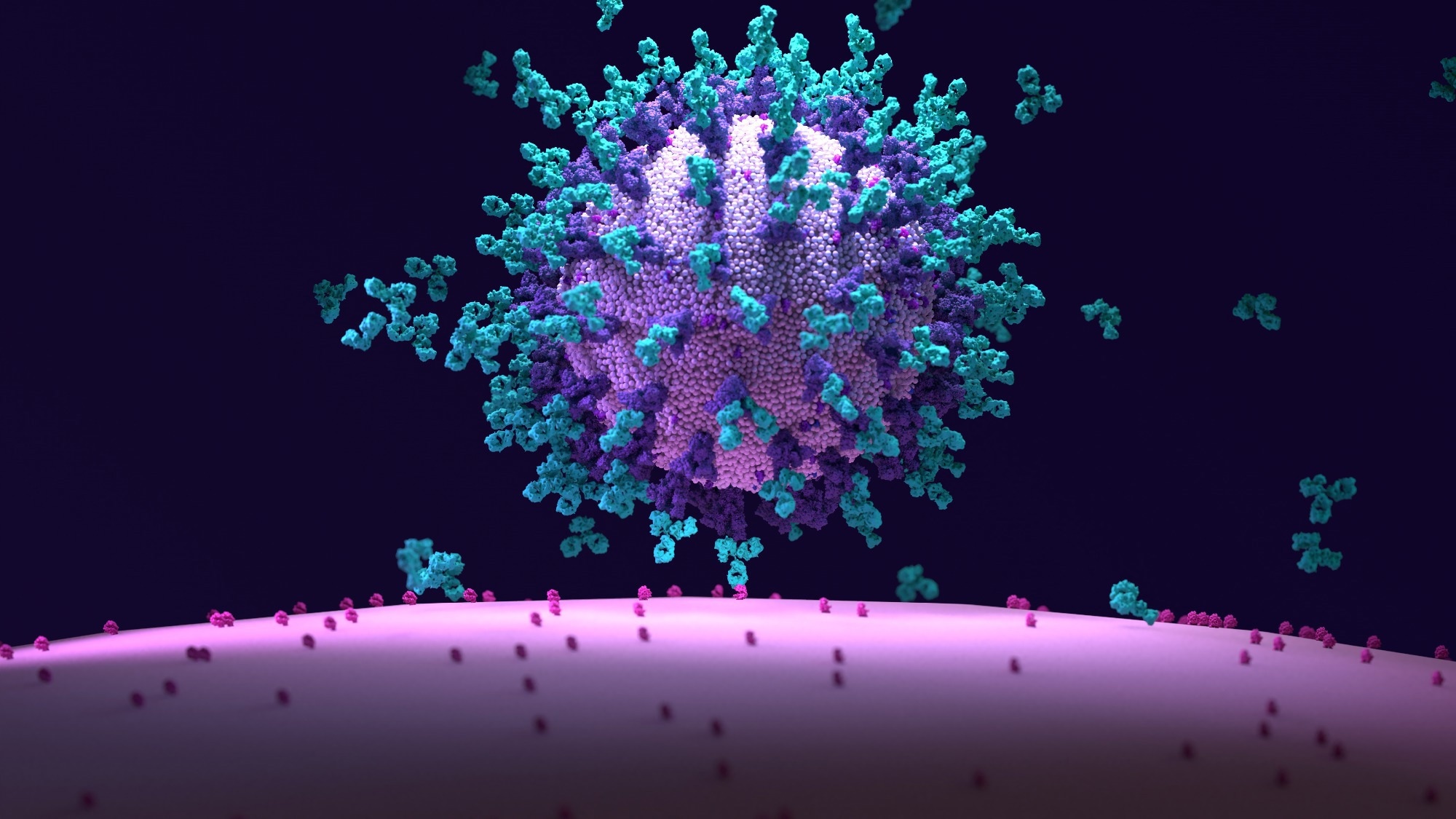In a recent study posted to the bioRxiv preprint* server, researchers in Sweden investigated severe acute respiratory syndrome coronavirus 2 (SARS-CoV-2) spike (S) protein amyloid as a potential triggering factor for protein misfolding and amyloid formation in neurodegenerative diseases (NDs).
Neurodegenerative diseases such as Creutzfeldt-Jakob disease (CJD) and Alzheimer’s disease (AD) are accelerated by the conversion of human proteins into misfolded amyloid fibril aggregates. This process is self-perpetuating through seeding from preformed fibril seeds. SARS-CoV-2 S, abundant in the inflammatory response, is a plausible mechanism for amyloid fibril formation.
Study: SARS-CoV-2 Spike amyloid fibrils specifically and selectively accelerates amyloid fibril formation of human prion protein and the amyloid β peptide. Image Credit: Design_Cells / Shutterstock

 *Important notice: bioRxiv publishes preliminary scientific reports that are not peer-reviewed and, therefore, should not be regarded as conclusive, guide clinical practice/health-related behavior, or treated as established information.
*Important notice: bioRxiv publishes preliminary scientific reports that are not peer-reviewed and, therefore, should not be regarded as conclusive, guide clinical practice/health-related behavior, or treated as established information.
About the study
In the present study, researchers performed cross-seeding neurodegenerative disease-related proteins with S protein amyloid fibrils.
In the in vitro environment, seeding studies were carried out by cross-seeding human prion protein (HuPrP)- and the Aβ1-42 protein-derived with seven distinct amyloid protein fibrils obtained from SARS-CoV-2 S peptides. The researchers examined whether SARS-CoV-2 S protein-derived amyloid protein accelerates the human A peptide and HuPrP fibril formation. Thus, prefabricated fibrils from seven SARS-CoV-2 Wuhan-Hu-1 strain S amyloidogenic sequences (spike seeds)-derived peptides, each 20 amino-acid long, were added, matching the starting protein sequence of the S glycoprotein.
E. Coli was used to make human PrP. To test seeding effect specificity, 10% seed concentrations of different amyloidogenic proteins such as Aβ1-42, TTR, insulin, and lysozyme were introduced. ThT fluorescence changes with time were used to monitor fibrillation. To slow the fibrillation rate of the unseeded HuPrP reaction and dissolve the S protein peptides, hexafluoro-isopropanol (HFIP) was used. The heterologous seed might be a protein that differs from the substrate by a single point mutation, the same protein from a different species, or another protein related to the same illness.
The seeding effect of S protein amyloids was studied using Aβ1-42 as a substrate. Replicate reaction samples were obtained for inspection using transmission electron microscopy (TEM) while ThT was monitoring Aβ1-42 fibril development. To match the greatest concentration of S protein peptide amyloids, the team added control seeds to HuPrP at 0.010 mg/mL concentration. The positive control was the fibrillar form of HuPrP90-231 at 0.0010 mg/mL concentration.
Results
Using an in vitro conversion experiment, the researchers discovered that S protein-amyloid fibril-seeded amyloid production of CJD-associated HuPrP was significantly accelerated. The HuPrP conversion assay was seeded with different in vitro-generated disease-associated amyloid fibrils, and the Aβ1-42 protein was exposed to a panel of control seeds, but no fibril development was accelerated for insulin, lysozyme, or TTR. The findings indicated seeding as a unique property of S protein-amyloid fibrils rather than a universal impact.
Positive controls included Aβ1-42 protein fibrils and an amalgamation of seven fibrillated S glycoprotein peptides, and both controls indicated seeding action. Further, S protein-amyloid fibril seeds enhanced amyloid fibril development in AD-associated Aβ1-42. Spike532 (532NLVKNKCVNFNFNGLTGTGV551) was most successful in seeding HuPrP, whereas Spike601 (601GTNTSNQVAVLYQDVNCTEV620) was most effective in seeding Aβ1-42, demonstrating substrate-dependent selectivity of the cross-seeding activity.
The development of Aβ1-42 fibrils was enhanced by all seven S protein amyloids. However, like with HuPrP seeding, there was a considerable differential in seeding efficiency across the various S protein amyloids, with Aβ1-42 being more responsive to Spike601. The exponential phase of growth was finished for all seeded samples at 120 minutes in the TEM study, whereas the unseeded specimen, lacking fibrillar components but rich in oligomeric structures, continued to be in the beginning nucleation phase. Amyloid fibrils were seen in all S peptide amyloid-seeded samples.
The CJD-linked HuPrP and AD-linked Aβ1-42 peptides showed cross-seeding vulnerability with SARSCoV-2 S glycoprotein amyloids. Spike532 amyloid considerably shortened the lag period of amyloid production for HuPrP by a greater extent than other amyloid peptides, but Spike192 amyloid protein did not significantly reduce the lag period.
Spike532 seeding significantly reduced the lag period of HuPrP protein fibrillation by 80%, from 712 to 135 minutes on average. The 10-fold spike seed dilution nearly eliminated the seeding abilities of the S protein amyloids. Nevertheless, Spike532 amyloid almost retained its ability to reduce the lag period, with only a 10% reduction in the ability by the dilution.
The 0.010 mg/mL SARS-CoV-2 S protein mixture reduced lag duration from 6.75 hours to 5.1 hours (25%). Insulin fibrils reduced the lag period of HuPrP protein fibrillation considerably, while TTR, lysozyme, and the Aβ1-42 protein fibrils did not. The authors did not propose a mechanistic explanation for the lower Aβ1-42/40 ratio among SARS-CoV-2-positive individuals, but Aβ1-42 accumulation might be one. All seven investigated SARS-CoV-2 S peptide amyloids significantly reduced the duration of fibril generation, especially in an already swift, unseeded response. Spike532 was the most efficient at HuPrP seeding, while Spike601 was the most efficient for Aβ1-42 seeding.
Overall, the study findings showed that SARS-CoV-2 S glycoprotein amyloid fibrils preferentially and specifically enhanced the production of HuPrP and amyloid peptide amyloid fibrils. The findings, albeit solely in vitro, indicated that S protein-amyloid fibril cross-seeding may be involved in the growing number of cases of CJD, AD, and perhaps other NDs in the aftermath of COVID-19.

 *Important notice: bioRxiv publishes preliminary scientific reports that are not peer-reviewed and, therefore, should not be regarded as conclusive, guide clinical practice/health-related behavior, or treated as established information.
*Important notice: bioRxiv publishes preliminary scientific reports that are not peer-reviewed and, therefore, should not be regarded as conclusive, guide clinical practice/health-related behavior, or treated as established information.








